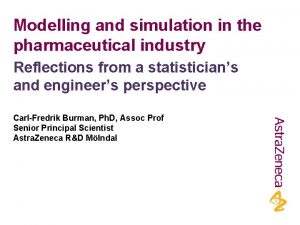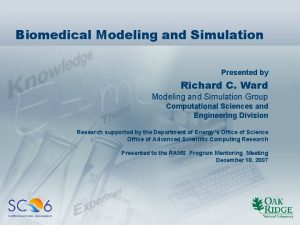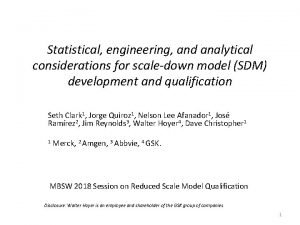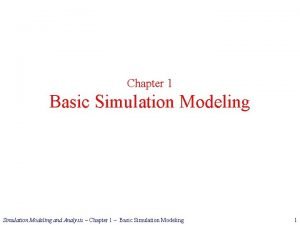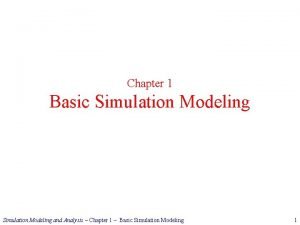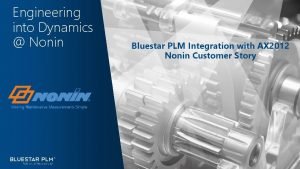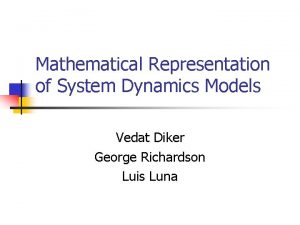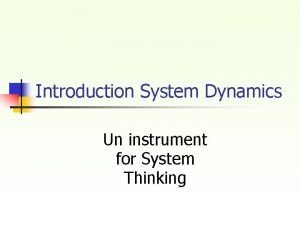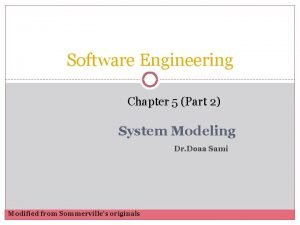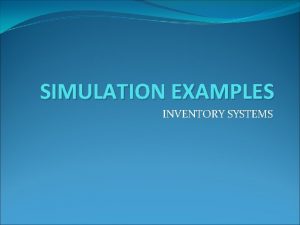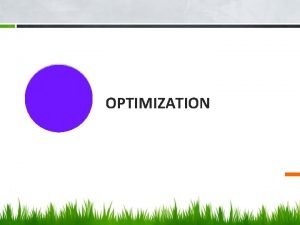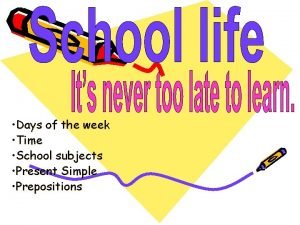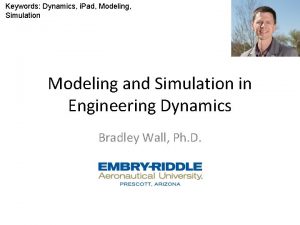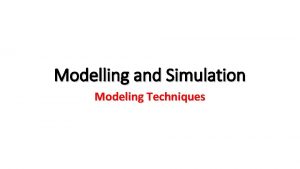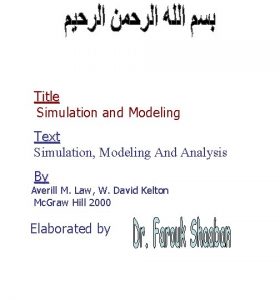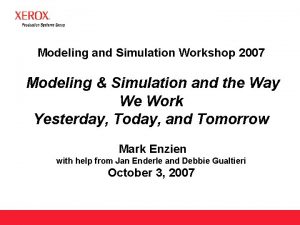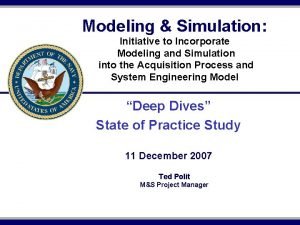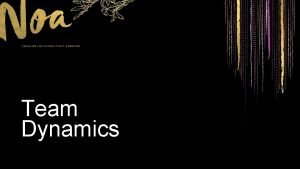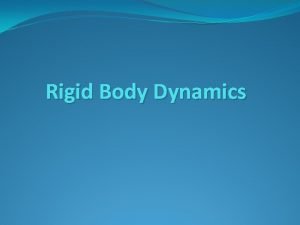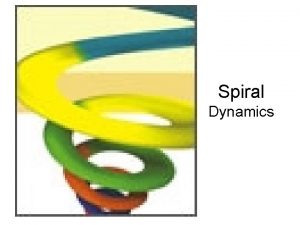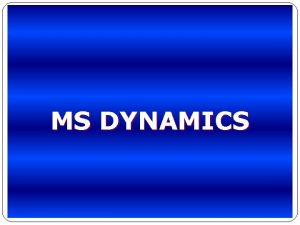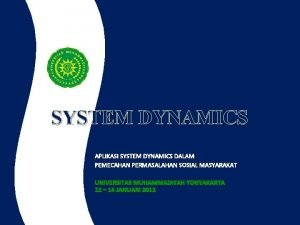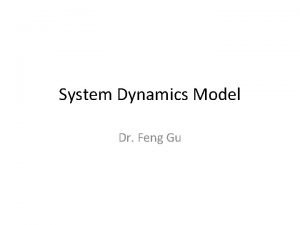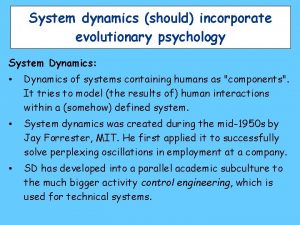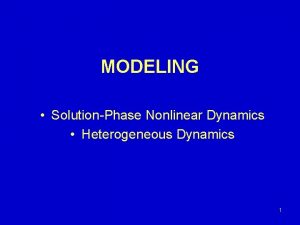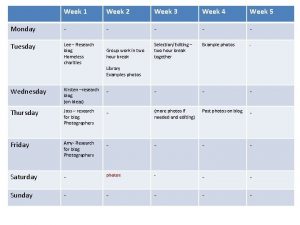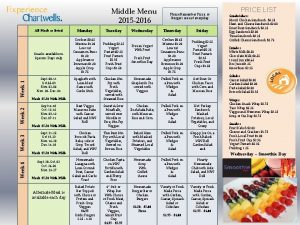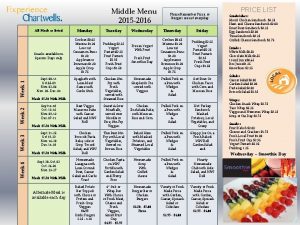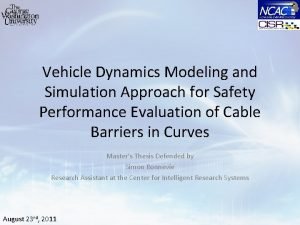System Dynamics Simulation and Modeling Simulation Modeling Week


































- Slides: 34

System Dynamics Simulation and Modeling Simulation & Modeling Week 2 – System Dynamics 1

System Dynamics: an introduction • This section will provide an introduction to system dynamics and develops its philosophical linkage to science • It also designed to provoke critical thinking about methods we use in our scientific endeavour. Simulation & Modeling Week 2 – System Dynamics Slide 2 2

Understanding Systems Simulation & Modeling Week 2 – System Dynamics 3

Understanding Systems Simulation & Modeling Week 2 – System Dynamics 4

Understanding Systems Simulation & Modeling Week 2 – System Dynamics 5

“No Shared Understanding!” A car company lost money and a “task-force” found that: • The marketing group thought the problem was due to lack of advertising and promotional support • The sales group blamed lack of promotion and dealer support • The manufacturing and dist. group blamed inaccurate forecasting by the marketing and sales groups, causing poor production planning and high cost • The Finance department blamed budget overruns by all departments and unreliable forecasting from the marketing group • The legal department blamed a lack of new franchising agreements, which meant that the company lacked new products Simulation & Modeling Week 2 – System Dynamics 6

The Parable of the Boiled Frog • • Japanese car market share in US www. detnew. com/2002/autosinsider/ke epup/ b 07 -383940. htm • Suppose you want to boil a frog. How do you do it? You could place the frog into a pot of hot water, but as soon as it feels the heat, it will jump out. So, what can you do? Put a pot of cool water on the stove and then add the frog. Not sensing danger the frog will stay. Next, turn the burner on low to slowly heat the water. As the water warms, the frog relaxes. The warmth feels good. As the water gets hotter it acts like a steam bath draining away energy and deepening the frog's relaxation. The frog becomes sleepy and has less and less energy while the water is getting hotter and hotter. By the time the frog realizes its danger, the water is beginning to boil, and it is too • What is the moral of the story? Be vigilant. Don't let unexpected change creep up • on you. Don't become a "boiled frog. " Pay close attention to what is going on • around you, so that you can notice when the "water" is Simulation & Modeling Week 2 – System Dynamics 7

The Blind Men and the Elephant John Godfrey Saxe www. wordfocus. com/word-act-blindmen. html Moral of the Story People tend to understand only a tiny portion of Reality and then extrapolate all manner of dogmas from that, each claiming only his one is the Simulation & Modeling Week 2 – System Dynamics correct version 8

Characteristics of Complex Systems • Tightly Coupled “Everything influences everything else” “You can’t just do one thing” • Dynamic Change occurs at many time scales • Policy Resistant Many obvious solutions to problems fail or actually worsen the situation. • Counterintuitive Cause and effect are distant in time and space • Exhibit Tradeoffs Long term behaviour is often different from short term behaviour Simulation & Modeling Week 2 – System Dynamics 9

The Structure of Systems • Physical Structure • Organisational Structure • Stocks and flows of people, energy, money etc Time delays, resources, external environment Organisation of decision making units Lines of authority and responsibility (formal and informal) Information availability, and quality, incl. persuasiveness, delay, bias, distortion Decision Making Structure Decision-makers mental models of the system Culture and tradition Incentives, rewards, goals of individual decision makers Habits, routine, standard operational procedures Cognitive limits of decision making Simulation & Modeling Week 2 – System Dynamics 10

Systems Error Simulation & Modeling Week 2 – System Dynamics 11

System Dynamics Events Behaviour System Structure As we move our perspective from the event level to the structural level, we have a better understanding of what is really going on in a system. We also increase our ability to influence and change the system’s behaviour, i. e. , we can make adjustments to the structure which are consistent Simulation & Modeling Week 2 – System Dynamics 12

Reference Mode Whenever we study a system, we are interested in a certain ‘problem’, i. e. , we are trying to explain a system’s behaviour §It is a graphical or verbal description of the social process of interest. §can be stated by drawing a graph of the expected behaviours of major variables. §A verbal treatment of the reference mode may actually convey more of the purpose of the model than a graph of Simulation & Modeling Week 2 – System Dynamics 13

Example : Increasing Crime Events Behaviour “Drugs are a big worry for me. Not least because of the crimes that people commit to fund their dependency. We want the policy to bust these System Structurerings and destroy the drugs. They say they’re doing it and they keep showing us sacks of cocaine that they seized but the crime problem Simulation & Modeling Week 2 – System Dynamics seems to be getting worse” 14

Increasing Crime Events Behaviour What are the main variables described in the statement? What is the reference mode (behaviour) of this system? System Structure Time Simulation & Modeling Week 2 – System Dynamics 15

Increasing Crime What is the structure of this system? Events Behaviour System Structure What is the causal loop diagram which explains the observed behaviour? Drug Related Crime Price Drug Seizures Demand Simulation & Modeling Call for Police Action Week 2 – System Dynamics Supply 16

Background to System Dynamics • System Dynamics is a computer-based modelling approach that employs computer simulation and system thinking methods. • The conception and development of system dynamics took place during the 1950’s and was formed from the work carried out at MIT • Professor Jay Forrester (Forrester, 1961) laid down the foundations of the discipline and later defined the methods and techniques associated with this methodology. • Coyle (1996) describes SD as the application of feedback control systems principles and techniques to managerial, organisational and Simulationsocio-economic problems. & Modeling Week 2 – System Dynamics Slide 17 17

Origins of System Dynamics § SD was first called “ Industrial Dynamics” and originates from the field of engineering known as control systems theory and operational research § Jay Forrester, the pioneer of SD defines it as “. . the study of information feedback characterisation of industrial enterprise to show structure, amplification, and time delays interact to influence the success of the enterprise” § The idea of modelling socio-economic systems in feedback terms is not original to Forrester. § Forrester gives credit to A. Tustin for considering in detail the analogy between servo-mechanisms and economic systems. § Forrester's contribution to SD was to provide a simple [Sources: Forrester, 1961; Tustin, 1953] Simulation & Modeling Week 2 – System Dynamics Slide 18

System Dynamics • SD is based on servomechanism theory and other systems analysis techniques using digital computers to solve large numbers of equations in short period of time. • The mathematical foundations of SD make it a powerful method: § to encompass a “body of knowledge, § a theory of representation § and a methodology for designing and analysing complex feedback systems and their dynamic behaviour. • Advantages of SD as a problem-solving methodology are that it captures both the quantitative and qualitative. • Simulation SD &modelling techniques have been used to develop Simulation &Modeling Week 2 – System Dynamics Slide 19 19

SD - a theory of representation • • SD simulation models can be considered as a representational system, in a broad sense as a language that allows us to view and describe reality. There are three types of knowledge: § § § Structural knowledge: represents theoretical knowledge or structure of the model highlighting the relationship between variables, their polarity and direction of influence; Quantitative knowledge: reference modes or known behaviour of a specific phenomenon; Operational knowledge: simulation behaviour of the model replicating past behaviour or predicting future system performance. Simulation & Modeling Week 2 – System Dynamics Slide 20 20

SD - a problem solving methodology Policy Implementation Understanding of a system Problem Definition Policy Analysis System Conceptualisation Simulation Model Formulation The modelling process "begins and ends with understandings of a system and its problems" (Richardson and Pugh, 1981: pp 16). The process is an iterative and non-linear. Increased understanding in itself increases our understanding of the Simulation Week 2 – System Dynamics problem& Modeling at hand. Slide 21

• Simulation in Business Modelling Simulation is one of the most fundamental approach to decision making. • The essence of Modelling is that a manager makes decisions in advance of the real product, services or process being created. • A tool to gain insights and explore possibilities through the formalised (situation) involved in using simulation models. • Simulation explores the consequences of decision making rather than directly advising on the decision itself - it is a predictive rather than an optimising technique. • Currently there are many tools both simulation language and packages that could be used for Simulation & Modeling Week 2 – System Dynamics Slide 22

Aims and Objectives of the SD Approach § SD, like other problem solving technique can be used in studying, exploring, understanding and solving problems. §To recreate the general behaviour of a system in terms of existing policies and structures. §Translation of the developed model into an appropriate computer language and simulation of the model. §To improve a system’s behaviour by suggesting alternative policies, processes and structures. §Interpretation of output of the existing developed model in an attempt to produce enhanced models Simulation & Modeling Week 2 – System Dynamics Slide 23

SD as a Method for Analysing Problems Prof G. Coyle describes SD in two ways: l“A method of analysing problems in which time is an important factor, and which involve the study of how a system can be defended against, or made to benefit from, the shocks that fall upon it from the outside world” l. AND, “SD is that branch of control theory which deals with socio-economic systems, and that branch of Management Science which deals with problems of controllability” [Source: Coyle, 1995] Simulation & Modeling Week 2 – System Dynamics Slide 24

SD as a tool for facilitating Understanding Roberts says “SD is the application of feedback control systems, principles and techniques to managerial, organisational, and socio-economic problems. ” Peter Senge explains that: SD is a “general methodology that embodies practical tools which are grounded in underlying theory for understanding how feedback structure of complex systems generates observed patterns of behaviour”. [Source: Roberts, 1987 & Senge, 1993] Simulation & Modeling Week 2 – System Dynamics Slide 25

A method for Analysing Complex Problems Eric Wolstenholme, defines SD as: l“A rigorous method for qualitative description, exploration and analysis of complex systems in terms of their processes, information, organisational boundaries and strategies; which facilitates quantitative simulation modelling and analysis for the design of system structure and control. ” [Source: Wolstenholme, 1993] Simulation & Modeling Week 2 – System Dynamics Slide 26

Relevance of SD In the context of improving our fundamental understanding of the business processes, we can start by constructing a simple model of the main processes l. Model the dynamics of the organisation l. Simulate a simplified view of the organisational processes l. Use this business model to solve problems l. This is a useful starting point for studying Simulation & Modeling Week 2 – System Dynamics and applying dynamic modelling, systems Slide 27

SD as a problem solving technique Fundamental transformation is needed in thinking about how organisations work, are structured, designed & managed: o To capture our mental models focusing on existing problems. o Tools that go beyond the capability of spreadsheets. o Tools that explain to managers how their organisations perform and how process transformation can be carried out. Simulation & Modeling Week 2 – System Dynamics Slide 28

The Process of Modelling The modelling process can be divided into four stages: 1. Conceptualisation, 2. Formulation, 3. Testing, 4. Implementation. Simulation & Modeling Week 2 – System Dynamics Slide 29 29

Four stages of model construction 1. Conceptualisation § Definition of the question to be addressed- § Description of the time development of interest (the reference mode) and defining the time horizon and the range of time constants in the model Verbal description of the feedback loops that are assumed to have caused the reference mode (the basic mechanisms) Slide 30 Simulation & Modeling Week 2 – System Dynamics 30 §

Four stages of model construction 2. Formulation § Postulation of detailed structureselecting levels, selecting rates and describing their determinants § Selection of parameter values § Testing of the dynamic hypothesis Simulation & Modeling Week 2 – System Dynamics Slide 31 31

Four stages of model construction 3. Testing § Do the mechanisms actually create the reference mode? § Testing of model assumptions-Does the model include § Are the important variables reasonable? Are parameter values plausible/reasonable ? Simulation & Modeling Week 2 – System Dynamics Slide 32 32

Four stages of model construction 4. Implementation 1. Testing of model behaviour and sensitivity to perturbations 2. Testing the response to different policies 3. Identification of potential users Translation of study insights to an accessible form and Diffusion Simulation & Modeling Week 2 – System Dynamics 4. Slide 33 33

Bibliography l l l l l Coyle, G (1977) Management System Dynamics; Wiley. Interscience, London Dangerfield B & Vapenikova O, (1987); Dysmap 2 User Manual University of Salford. Forrester, J W (1961); Industrial Dynamics, MIT Press Forrester, J W (1968); Principles of Systems, MIT Press Pid, M. , (1992) Computer Simulation in Management Science, 3 Ed John Wiley, Chichester Richardson, G. P & Pugh, A L (1981); Introduction to System Dynamics Modelling with DYNAMO; MIT Press Roberts, N et al (1983), Introduction to Computer Simulation: The System Dynamics Approach; Addison - Wesley Tustin, A. (1953) The Mechanism of Economic Systems. Harvard University Press, Cambridge, Mass. Wolstenholme, E F (1990) System Enquiry. A System
 Role modeling theory
Role modeling theory Week by week plans for documenting children's development
Week by week plans for documenting children's development Simulation modeling and analysis law kelton
Simulation modeling and analysis law kelton Pharmaceutical simulation and modeling
Pharmaceutical simulation and modeling Introduction to modeling and simulation
Introduction to modeling and simulation Biomedical modeling and simulation
Biomedical modeling and simulation Simulasi adalah
Simulasi adalah Site:slidetodoc.com
Site:slidetodoc.com Dimensional modeling vs relational modeling
Dimensional modeling vs relational modeling Basic simulation modeling
Basic simulation modeling Basic simulation modeling
Basic simulation modeling Power system dynamics and stability lecture notes
Power system dynamics and stability lecture notes Power system dynamics and stability lecture notes
Power system dynamics and stability lecture notes Process modeling in system analysis and design
Process modeling in system analysis and design System requirements checklist output example
System requirements checklist output example Microsoft dynamics ax plm
Microsoft dynamics ax plm System dynamics
System dynamics Vedat diker
Vedat diker System dynamics
System dynamics System dynamics
System dynamics Is earth an open or closed system
Is earth an open or closed system Digestive system circulatory system and respiratory system
Digestive system circulatory system and respiratory system System modeling in software engineering
System modeling in software engineering What is domain model in software engineering
What is domain model in software engineering Rotational mechanical system example
Rotational mechanical system example Inventory simulation examples
Inventory simulation examples Rat cardiovascular system simulation
Rat cardiovascular system simulation Data and process modeling
Data and process modeling Linear quadratic function
Linear quadratic function Describe data and process modeling concepts and tools
Describe data and process modeling concepts and tools A company manufactures and sells x cellphones per week
A company manufactures and sells x cellphones per week 4 day school week pros and cons
4 day school week pros and cons Days of the week and months of the year
Days of the week and months of the year School subjects and days of the week
School subjects and days of the week Romeo and juliet act 1 scene 1 timeline
Romeo and juliet act 1 scene 1 timeline



